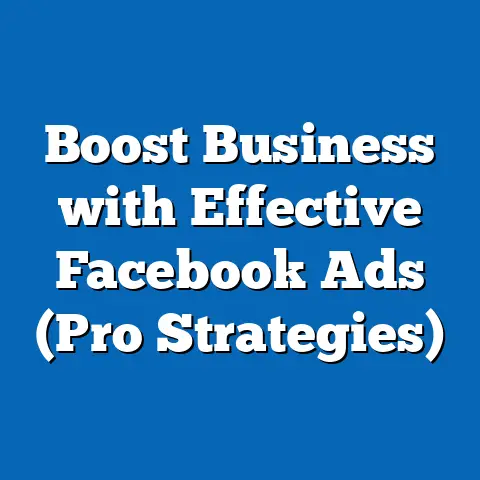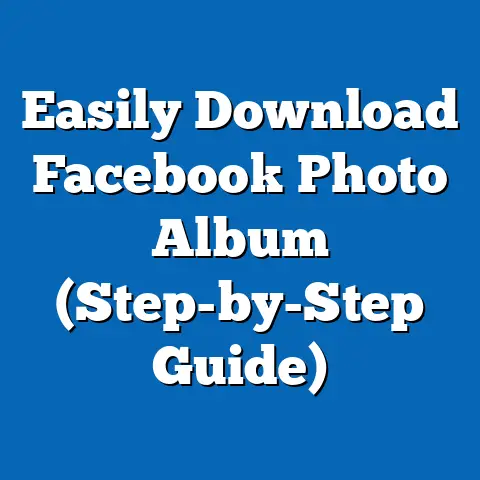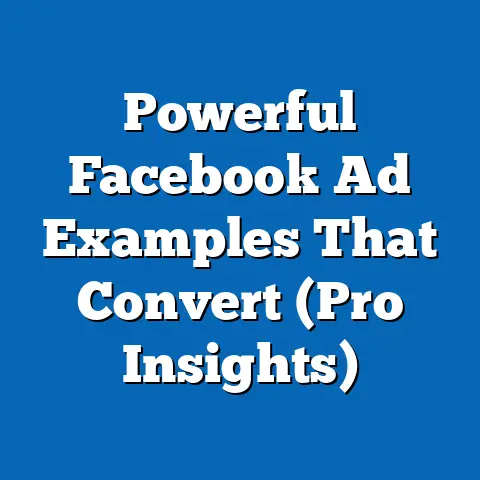Fixing Facebook Ads Mismatch (Effective Solutions Revealed)
Have you ever felt like you’re throwing money into a black hole with your Facebook ads? You meticulously craft your ad, target the “perfect” audience, and hit “publish” with high hopes, only to be met with crickets. Or worse, a handful of clicks that lead to nowhere. Believe me, I’ve been there. The frustration of a Facebook ads mismatch – when your ads just aren’t delivering the results you expect – is a feeling all too familiar to many marketers.
I remember one particular campaign I ran for a local bakery. We had mouth-watering images, a compelling offer, and what I thought was laser-focused targeting. Yet, the sales just weren’t reflecting the ad spend. It was like the message was getting lost in translation. It’s easy to feel defeated when this happens, questioning everything from your creative choices to your targeting strategy.
But don’t despair! This article is your guide to understanding and rectifying those frustrating mismatches. I’m going to walk you through identifying the root causes, implementing effective solutions, and ultimately transforming your Facebook ad campaigns into the lead-generating, revenue-driving machines they should be. I’ll share actionable insights based on my own experiences and industry best practices, so you can turn those ad frustrations into success stories. We’ll dive deep into the common pitfalls and the strategies I’ve used to overcome them, ensuring you’re not just creating ads, but creating ads that resonate and convert.
Understanding the Facebook Ads Mismatch
So, what exactly is a “Facebook Ads Mismatch?” It’s when there’s a disconnect between what your ads promise and what users experience after clicking on them. This can manifest in several ways:
-
Targeting Mismatch: You’re showing your ads to the wrong people, who aren’t interested in your product or service.
-
Creative Mismatch: Your ad visuals or copy don’t resonate with your target audience or accurately represent your brand.
-
Message Mismatch: The message in your ad doesn’t align with the content on your landing page, leading to confusion and a lack of conversions.
Targeting Mismatch: You’re showing your ads to the wrong people, who aren’t interested in your product or service.
Creative Mismatch: Your ad visuals or copy don’t resonate with your target audience or accurately represent your brand.
Message Mismatch: The message in your ad doesn’t align with the content on your landing page, leading to confusion and a lack of conversions.
Let’s break down the common causes of these mismatches:
-
Poor Audience Targeting: This is often the biggest culprit. Relying on broad demographics or inaccurate interest targeting can lead to showing your ads to people who simply aren’t your ideal customers. I’ve seen businesses target “entrepreneurs” when they really needed to target “small business owners with 5-10 employees in the tech industry.” The devil is in the details!
-
Misalignment Between Ad Creatives and Landing Page Content: Imagine clicking on an ad for a “free trial” and landing on a page that requires a credit card upfront. That’s a mismatch! The landing page needs to deliver on the promise made in the ad.
-
Ineffective Call-to-Action (CTA) Strategies: A weak or confusing CTA can leave potential customers unsure of what to do next. “Learn More” might not be as effective as “Get Your Free Quote Now!”
Poor Audience Targeting: This is often the biggest culprit. Relying on broad demographics or inaccurate interest targeting can lead to showing your ads to people who simply aren’t your ideal customers. I’ve seen businesses target “entrepreneurs” when they really needed to target “small business owners with 5-10 employees in the tech industry.” The devil is in the details!
Misalignment Between Ad Creatives and Landing Page Content: Imagine clicking on an ad for a “free trial” and landing on a page that requires a credit card upfront. That’s a mismatch! The landing page needs to deliver on the promise made in the ad.
Ineffective Call-to-Action (CTA) Strategies: A weak or confusing CTA can leave potential customers unsure of what to do next. “Learn More” might not be as effective as “Get Your Free Quote Now!”
The impact of these mismatches can be devastating. Not only do they waste your ad budget, but they can also damage your brand reputation. Think about it: a negative user experience can lead to negative reviews and word-of-mouth, undoing all the hard work you’ve put into building your brand. According to a recent study, 79% of consumers will abandon a brand after just one bad experience. That’s a statistic that should make every marketer sit up and take notice!
Identifying Your Mismatch
Before you can fix a problem, you need to diagnose it. And in the world of Facebook ads, that means diving into your analytics. Facebook Ads Manager is a treasure trove of data, if you know how to use it.
Here are some key metrics I always monitor:
-
Click-Through Rate (CTR): This tells you how many people are clicking on your ad after seeing it. A low CTR indicates that your ad creative or targeting might be off. What I always do is compare it to industry benchmarks. If my CTR is significantly lower than the average for my industry, I know there’s room for improvement.
-
Conversion Rate: This measures how many people are taking the desired action (e.g., making a purchase, filling out a form) after clicking on your ad. A low conversion rate suggests a mismatch between your ad and your landing page.
-
Cost Per Acquisition (CPA): This is the cost of acquiring one customer through your ad campaign. A high CPA indicates that your campaign is inefficient and needs optimization.
-
Engagement Levels: Pay attention to likes, comments, and shares. High engagement suggests that your ad is resonating with your audience, even if they’re not converting immediately.
Click-Through Rate (CTR): This tells you how many people are clicking on your ad after seeing it. A low CTR indicates that your ad creative or targeting might be off. What I always do is compare it to industry benchmarks. If my CTR is significantly lower than the average for my industry, I know there’s room for improvement.
Conversion Rate: This measures how many people are taking the desired action (e.g., making a purchase, filling out a form) after clicking on your ad. A low conversion rate suggests a mismatch between your ad and your landing page.
Cost Per Acquisition (CPA): This is the cost of acquiring one customer through your ad campaign. A high CPA indicates that your campaign is inefficient and needs optimization.
Engagement Levels: Pay attention to likes, comments, and shares. High engagement suggests that your ad is resonating with your audience, even if they’re not converting immediately.
But analytics aren’t the whole story. You also need to actively seek feedback from your audience.
-
A/B Testing: This is a powerful way to test different ad creatives, targeting options, and landing pages to see what performs best. I once ran an A/B test where I simply changed the headline on my landing page, and it resulted in a 30% increase in conversions!
-
Audience Surveys: Ask your customers directly what they think of your ads and landing pages. This can provide valuable qualitative insights that you won’t find in your analytics.
A/B Testing: This is a powerful way to test different ad creatives, targeting options, and landing pages to see what performs best. I once ran an A/B test where I simply changed the headline on my landing page, and it resulted in a 30% increase in conversions!
Audience Surveys: Ask your customers directly what they think of your ads and landing pages. This can provide valuable qualitative insights that you won’t find in your analytics.
By combining data-driven insights with direct feedback, you can pinpoint exactly where your Facebook ads mismatch lies.
Effective Solutions to Fix Mismatches
Now for the good stuff: the solutions! Here are some actionable strategies I’ve used to fix Facebook ads mismatches and achieve significant improvements in campaign performance.
Target Audience Refinement
This is where the magic happens. The more precise your targeting, the more likely you are to reach your ideal customers.
-
Facebook Audience Insights: This tool is your best friend. It allows you to analyze the demographics, interests, and behaviors of your target audience. Use it to identify new targeting opportunities and refine your existing audiences. I like to use it to see what pages my target audience likes, what topics they’re interested in, and what devices they’re using. This helps me create more relevant ads that speak directly to their needs.
-
Custom Audiences: Upload your existing customer list to create a custom audience of people who already know and love your brand. You can then use this audience to create lookalike audiences, which are people who share similar characteristics with your existing customers. This is a great way to expand your reach while still targeting highly qualified leads.
-
Detailed Targeting: Don’t be afraid to get granular with your targeting options. You can target people based on their demographics, interests, behaviors, and even life events. The more specific you are, the better.
Facebook Audience Insights: This tool is your best friend. It allows you to analyze the demographics, interests, and behaviors of your target audience. Use it to identify new targeting opportunities and refine your existing audiences. I like to use it to see what pages my target audience likes, what topics they’re interested in, and what devices they’re using. This helps me create more relevant ads that speak directly to their needs.
Custom Audiences: Upload your existing customer list to create a custom audience of people who already know and love your brand. You can then use this audience to create lookalike audiences, which are people who share similar characteristics with your existing customers. This is a great way to expand your reach while still targeting highly qualified leads.
Detailed Targeting: Don’t be afraid to get granular with your targeting options. You can target people based on their demographics, interests, behaviors, and even life events. The more specific you are, the better.
Creative Optimization
Your ad creative is what grabs people’s attention and convinces them to click. Here’s how to make sure it’s doing its job:
-
Ad Copy: Your ad copy should be clear, concise, and compelling. Highlight the benefits of your product or service and address your audience’s pain points. Use strong verbs and a sense of urgency to encourage clicks. I always try to write my ad copy as if I’m speaking directly to my ideal customer. What are their biggest challenges? What are their aspirations? How can my product or service help them achieve their goals?
-
Visuals: Use high-quality images or videos that are visually appealing and relevant to your target audience. Make sure your visuals are consistent with your brand and accurately represent your product or service. A/B test different visuals to see what performs best. I’ve found that user-generated content (UGC) often performs exceptionally well, as it feels more authentic and relatable.
Ad Copy: Your ad copy should be clear, concise, and compelling. Highlight the benefits of your product or service and address your audience’s pain points. Use strong verbs and a sense of urgency to encourage clicks. I always try to write my ad copy as if I’m speaking directly to my ideal customer. What are their biggest challenges? What are their aspirations? How can my product or service help them achieve their goals?
Visuals: Use high-quality images or videos that are visually appealing and relevant to your target audience. Make sure your visuals are consistent with your brand and accurately represent your product or service. A/B test different visuals to see what performs best. I’ve found that user-generated content (UGC) often performs exceptionally well, as it feels more authentic and relatable.
Landing Page Alignment
Your landing page is where the rubber meets the road. It’s where potential customers decide whether or not to take the desired action.
-
Mirror the Promise: Ensure that your landing page delivers on the promise made in your ad. If your ad promises a “free trial,” your landing page should offer a free trial, not a sales pitch.
-
Consistent Messaging: Use the same language and tone on your landing page as you did in your ad. This will create a seamless experience for users and build trust.
-
Clear Call-to-Action: Make it easy for users to take the desired action by including a clear and prominent call-to-action button.
Mirror the Promise: Ensure that your landing page delivers on the promise made in your ad. If your ad promises a “free trial,” your landing page should offer a free trial, not a sales pitch.
Consistent Messaging: Use the same language and tone on your landing page as you did in your ad. This will create a seamless experience for users and build trust.
Clear Call-to-Action: Make it easy for users to take the desired action by including a clear and prominent call-to-action button.
Call-to-Action Strategies
Your call-to-action is the final nudge that encourages users to convert.
-
Use Strong Verbs: Use action-oriented verbs that tell users exactly what you want them to do. Examples include “Get Started,” “Download Now,” “Shop Now,” and “Sign Up.”
-
Create a Sense of Urgency: Use language that creates a sense of urgency, such as “Limited Time Offer” or “While Supplies Last.”
-
Make it Prominent: Your call-to-action button should be visually prominent and easy to find on your landing page.
Use Strong Verbs: Use action-oriented verbs that tell users exactly what you want them to do. Examples include “Get Started,” “Download Now,” “Shop Now,” and “Sign Up.”
Create a Sense of Urgency: Use language that creates a sense of urgency, such as “Limited Time Offer” or “While Supplies Last.”
Make it Prominent: Your call-to-action button should be visually prominent and easy to find on your landing page.
Retargeting Strategies
Retargeting is a powerful way to reach users who have already interacted with your brand but haven’t yet converted.
-
Website Retargeting: Show ads to people who have visited your website but haven’t made a purchase or filled out a form.
-
Engagement Retargeting: Show ads to people who have engaged with your Facebook page or ads in the past.
-
Custom Audience Retargeting: Show ads to people on your customer list who haven’t yet made a purchase.
Website Retargeting: Show ads to people who have visited your website but haven’t made a purchase or filled out a form.
Engagement Retargeting: Show ads to people who have engaged with your Facebook page or ads in the past.
Custom Audience Retargeting: Show ads to people on your customer list who haven’t yet made a purchase.
Retargeting allows you to stay top-of-mind with potential customers and remind them of the value you offer. I’ve found that retargeting campaigns often have a significantly higher conversion rate than initial prospecting campaigns.
Case Studies and Success Stories
Let’s look at a couple of real-world examples of businesses that successfully fixed their Facebook ad mismatches:
-
The E-commerce Startup: A clothing e-commerce startup was struggling with low conversion rates on their Facebook ads. After analyzing their data, they realized that their targeting was too broad. They refined their targeting to focus on specific interests and behaviors related to their target audience, and they also created more visually appealing ad creatives. As a result, their conversion rates increased by 50%.
-
The Local Restaurant: A local restaurant was running Facebook ads to promote their lunch specials, but they weren’t seeing much success. After conducting a survey, they discovered that their target audience was primarily interested in healthy options. They updated their ad copy and visuals to highlight their healthy menu items, and their sales increased by 30%.
The E-commerce Startup: A clothing e-commerce startup was struggling with low conversion rates on their Facebook ads. After analyzing their data, they realized that their targeting was too broad. They refined their targeting to focus on specific interests and behaviors related to their target audience, and they also created more visually appealing ad creatives. As a result, their conversion rates increased by 50%.
The Local Restaurant: A local restaurant was running Facebook ads to promote their lunch specials, but they weren’t seeing much success. After conducting a survey, they discovered that their target audience was primarily interested in healthy options. They updated their ad copy and visuals to highlight their healthy menu items, and their sales increased by 30%.
These examples demonstrate that with careful analysis and targeted solutions, you can overcome Facebook ads mismatches and achieve significant improvements in your campaign performance.
Conclusion
Facebook ads mismatch can be a frustrating experience, but it’s not insurmountable. By understanding the common causes of mismatches, identifying your specific issues, and implementing effective solutions, you can transform your Facebook ad campaigns into powerful tools for generating leads and driving revenue.
Remember, the key is to be data-driven, customer-focused, and constantly testing and optimizing your campaigns. Don’t be afraid to experiment and try new things. The world of Facebook advertising is constantly evolving, so you need to be willing to adapt and learn.
So, take action today! Review your Facebook ad campaigns, identify any potential mismatches, and start implementing the solutions I’ve outlined in this article. I’m confident that with a little effort and persistence, you can turn those ad frustrations into success stories and unlock the full potential of Facebook advertising for your business.






